If you’re using social media as a dumping ground for links, you’re doing it wrong. There’s more to social media than promoting your content.
You’re missing out on the more social side of social media, like building your network and making friends. And your accounts won’t be much fun to follow.
There are three types of social posts. And blending them together is part of social media best practices. Here’s a breakdown of the “Social Media Rule of Thirds.”
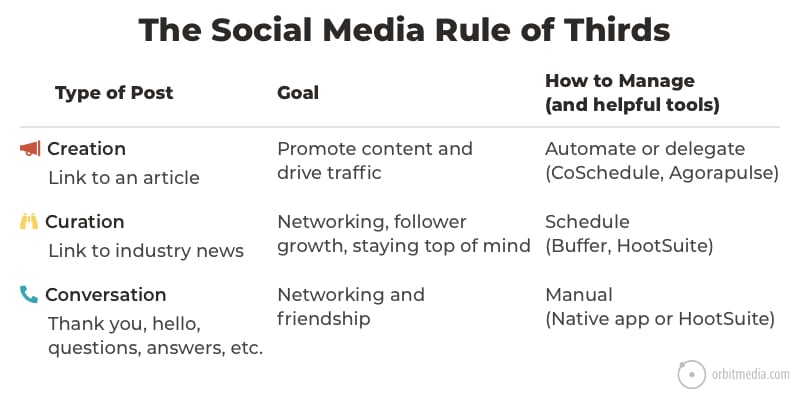
1. Creation and promotion: Driving traffic
Promote the content created by you or your brand. It’s helpful when these posts are seen (impressions) or engaged with (likes, comments, shares) but the true goal is traffic (clicks).
Working harder on these social media posts makes a big difference. If you just click the share button next to your article, don’t expect much for that 2-second effort. But spend five or ten minutes on a single social post and you may notice the difference immediately.
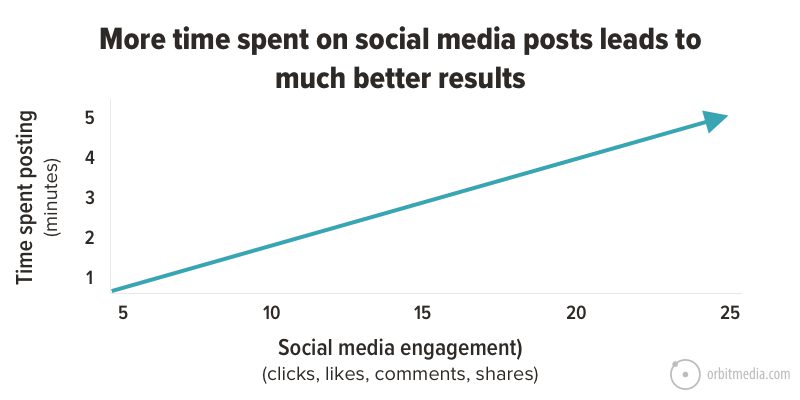
The best-in-class promotional posts include a lot of little elements, each of which makes the post more engaging.
- Headline best practices
Numbers, questions, specificity, urgency and emotion all make the difference. - Secondary headline
Take a second bite at the apple and give readers another benefit of clicking your link. - Special characters and emojis
They create visual prominence and stand out in a stream of text. They can be simple and professional ✔️or a bit more fun 🤪…depending on your brand. - Hashtags
Unless you’re using Instagram, one or two is plenty. - Line breaks
Claim more real estate in the social stream simply by adding breaks and adding whitespace. You can also add tiny lists.
Note: option+8 creates a dot. Combine that with line breaks and you have a bullet list. - Quotes
Pull out a short, impactful quote from the article you’re promoting and add it to the social post within quotes. - Visuals
Images are important. But video is the best. By far, the most successful traffic driving posts are little one-minute video commercials for the content. If you haven’t tried this yet, here’s our step-by-step guide for creating social media videos. It is the most effective social media tactic that we’ve ever tried. - Mentions
The social posts should mention anyone who contributed to the article. - Link with campaign tracking code
If you don’t use a URL builder to add campaign tracking code to these links, you’ll never know the impact of these efforts in your Analytics. All social traffic, from your posts and from others who post your content, will be lumped together.
ProTip: If you’re promoting a long article with several sections, adding HTML anchors to subsections allows you to create social posts that link to specific sections of the article. You can create social posts that bring the visitor directly to deeper parts of the page.
Example of a content promotion social post
Put these together and you get a very engaging post.
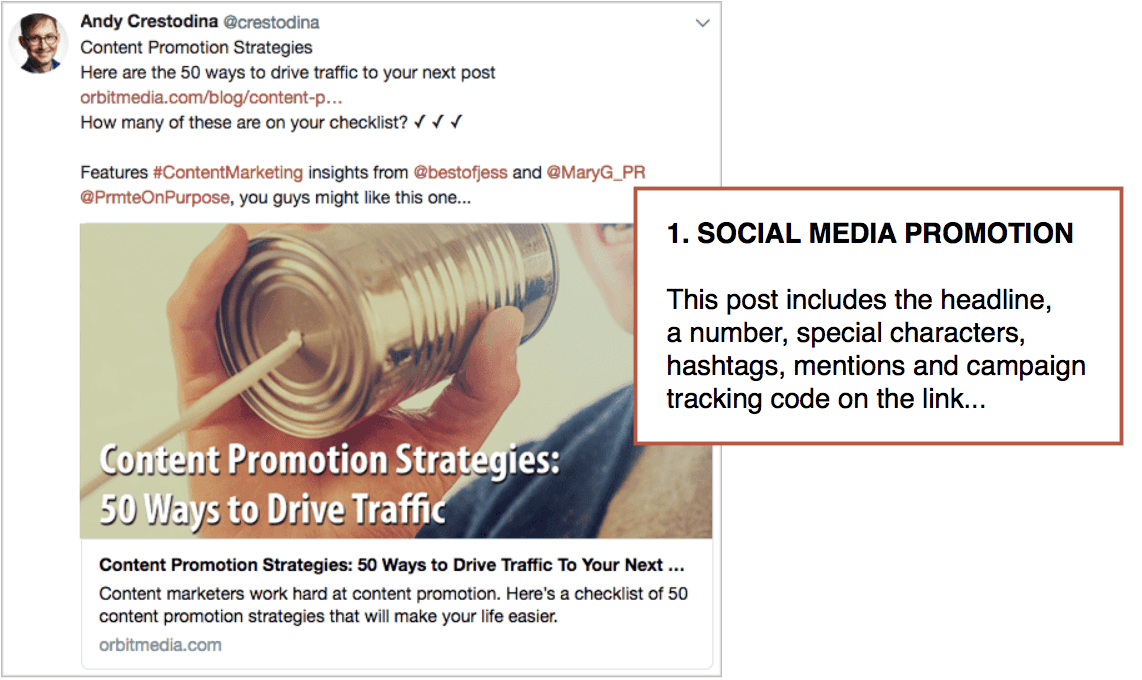
How to manage content promotion posts …automation
Assuming that your content strategy includes evergreen (non-news) content, as in content that doesn’t go out of date quickly, you can automate this type of social post.
Tools such as CoSchedule can be loaded up with posts and variants, visuals and links. This kind of social media automation is efficient and effective.
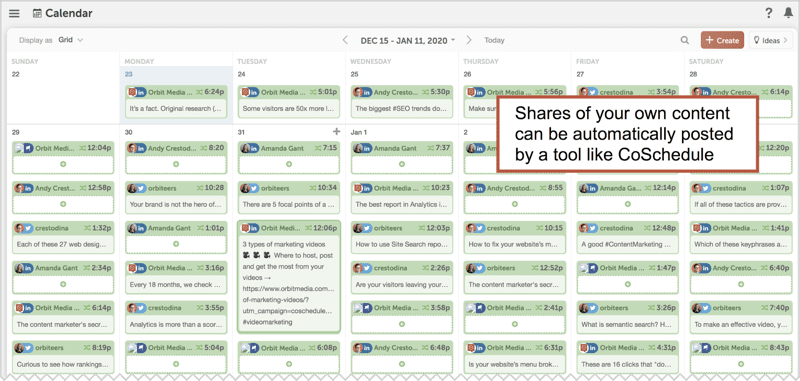
These tools help you avoid sharing the identical post over and over, which is prohibited by Twitter and not great for audience engagement. CoSchedule also helps you organize content and collaborate with your team. And of course, it can add that campaign tracking code to every post.

2. Curation: Industry content and networking
These are the posts where you share other people’s content. They make your stream more relevant and less spammy. They also have the potential to help you build relationships. It’s all part of influencer marketing, account based marketing, digital PR and blogger relations.
Industry news, information, advice and research
Keep your followers up-to-date on news and trends, making your stream more useful.
Mentions of your company in the press or in blog articles
Did your brand get mentioned somewhere? Share that article and mention the writer. It shows you noticed and you care. It’s just basic digital etiquette.
Smart SEOs set up alerts for brand mentions so they can do link reclamation. This is the very first step in link building.
Content created by influencers, partners and friends
Anyone you’d like to get to know better? Share their content and mention them. This makes you visible to that person in their notifications.
Do this consistently and you’ll gradually become known to all those people you’d like to eventually collaborate with. That includes journalists (for PR) and even prospects (for sales).
Example of a curation social post
These posts don’t link to your site, so there’s no need to add campaign tracking code. But don’t forget to mention the writer and anyone else featured in the article. If you don’t mention, you’re missing an opportunity to connect with a content creator.
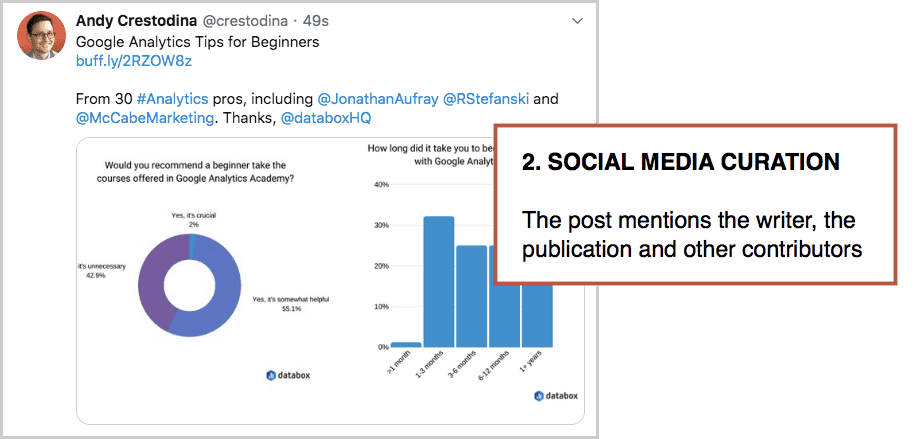
How to manage curation posts …schedule
This is a time management trick. Use time blocking and set aside time to do your research and reading. Go through your newsletters and social feeds once or twice per day at a scheduled time. This could be early morning or during lunch.
 |
Gini Dietrich, SPINSUCKS.COM“The biggest challenge with social media is it’s a time suck. You go on there with a sole purpose and emerge an hour later, having accomplished nothing. That’s why setting time aside to do this work is so important…and then don’t go back to it for the rest of the day. Block 30 minutes on your calendar each day, do your work, and get off. If you do, you’ll be effective and smart with your time—and still reach your social media goals.” |
You’re sure to find two or three interesting pieces. But if you share them all right then, they’ll be bunched up in your social stream. Schedule them so they’ll appear at different times throughout the day.
Buffer and Octopost are both good social media management tools for scheduling social media posts. They have mobile apps and browser plugins that let you schedule posts with a click, but that won’t add the mention or help you network with the writer.
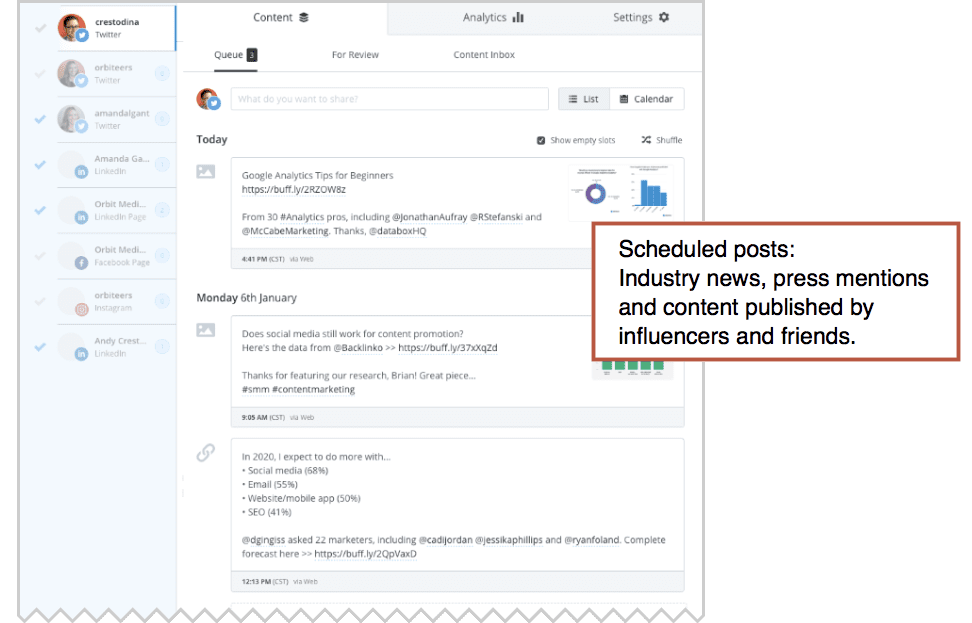
3. Conversation: The personal interactions
This is the final third in the rule of thirds. It is the most social part of social media. These are the hellos and thank yous. The answers to questions. The thoughtful comment. Talking directly to influencers, customers, strangers, friends and anyone else!
These posts make your account more personal, more human.
 |
jimmy daly, ANIMALZ.CO“Goodwill goes a looooong way. Celebrate people when they do something cool and thank them if they share something you created.” |
This is one of the most important social media best practices. For businesses and brands, this is where the customer services happens. For individuals, this is networking and relationship building.
Example of a conversation social post
Here’s what it looks like in the social stream.
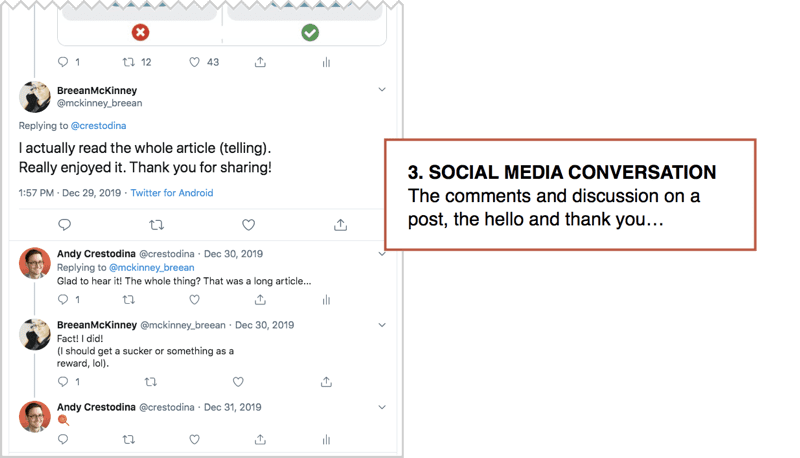
How to manage social media conversation …do it yourself manually
Do it from your phone. Do it on the app. However you do it, do it yourself.
You can delegate tasks, but you cannot delegate your voice. You can’t delegate friendship.
For businesses and brands, this is part customer service and part PR. If you choose to be active in a social media network, manage it deliberately. It may be a shared role or a dedicated social media community manager.
Is “The Rule of Thirds” really thirds?
No, it’s never an equal mix of the three. It’s never really thirds. Here are examples of recommendations from various pros over the years:
-
- 3:5:2
TA McCann recommends 5 posts of curated content, 3 self promotional post, 2 conversational posts. - 4:1:1
Drew Davis calls for 4 curated posts, 1 retweet, 1 post of your own content - 3:6:1
Gabe Bevilacqua once recommended the “Golden Ratio” formula: 30% are shares of content you created, 60% are curated from other sources and 10% are calls to action for actual conversions. I like this because it’s a reminder to sell stuff. - 5:5:5+
Shai Coggins calls for thirds: 5 posts of your original content, 5 posts of curated content from others, 5 responses and replies. The plus is for miscellaneous value adds such as #FollowFriday.
- 3:5:2
In reality, most social posts from most brands are self-promotional.
Regardless of the ratio, every great social media marketing program includes all three types with plenty of sharing, generosity and interaction. Together, they combine to drive traffic, build a brand, grow relationships and, eventually, increase rankings and revenue.
[ctt template=”1″ link=”4IyOg” via=”yes” ]If you’re not making friends, you’re doing it wrong.[/ctt]




